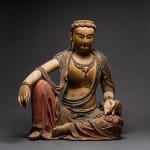Ming period wooden seated Bodhisattva, 1500 CE - 1700 CE
Wood
78.6 x 79 x 51 cm
31 x 31 1/8 x 20 1/8 in
31 x 31 1/8 x 20 1/8 in
RD.032
Further images
This is a wooden sculpture of the Bodhisattva Avalokiteshvara from Ming Dynasty. Here, Avalokiteshvara appears meditative and relaxed, seated informally in the “royal-ease” posture. Ornately dressed, with silk robes, fluttering...
This is a wooden sculpture of the Bodhisattva Avalokiteshvara from Ming Dynasty. Here, Avalokiteshvara appears meditative and relaxed, seated informally in the “royal-ease” posture. Ornately dressed, with silk robes, fluttering sashes, jewelry, he rests his right arm on his right knee, with one of the exquisitely carved fingers resting lightly against the cheek. The upper body is bare except for a delicate necklace and celestial scarves. The lower body is covered by a waist length tunic and all the details of the costume are enlivened by the use of red, green and blue pigments.
Bodhisattvas were originally depicted as the Buddha’s attendants but increasingly came to be venerated in their own right. The Bodhisattva of Mercy, known as Avalokiteshvara, or Guanyin in Chinese, is identifiable by the small seated Buddha that appears in the Headdress. This figure was so popular in China that by the Tang era its image outnumbered those of the Buddha. Although the headdress is missing from this figure, we can still confirm its identity as Avalokiteshvara since he rests in the conventional water-moon form.
Bodhisattvas were originally depicted as the Buddha’s attendants but increasingly came to be venerated in their own right. The Bodhisattva of Mercy, known as Avalokiteshvara, or Guanyin in Chinese, is identifiable by the small seated Buddha that appears in the Headdress. This figure was so popular in China that by the Tang era its image outnumbered those of the Buddha. Although the headdress is missing from this figure, we can still confirm its identity as Avalokiteshvara since he rests in the conventional water-moon form.







